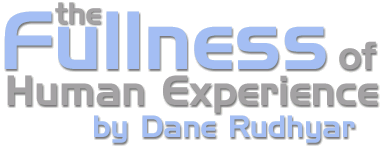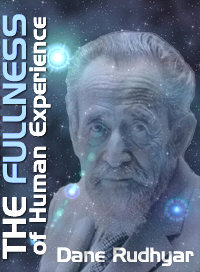 |
| Home | Bio | Art | Music | Literature | Civilization & Culture | Philosophy of Wholeness | Theosophy & Spirituality | Astrology |

CHAPTER EIGHT
Crises of Transition - 3 Being a living organism whose specific type of organization and structure belongs to the species Homo sapiens, and being a person operating as part of a collective, sociocultural whole are facts that have meaning at two fundamentally different levels. A human being who is not actually able to participate in a society and its culture is not a person. Such a being may be potentially a person or no longer a person, yet still exist as a naturally or artificially sustained living organism. A human being becomes a person when able to enter into purposeful, sustained, and effective two-way relationships with other human beings within a societal group. Such a relationship implies the capacity to communicate with other members of the group, however primitive the means of communication. Language, not only through words but also in gestures and direct psychic interchange, is the means most specifically used at the level of the human association. Animals — and possibly even cells — undoubtedly have modes of communication through which vital needs and biological impulses are conveyed, but human language has not only a life-maintaining or life-enhancing function; it makes possible the development of freedom of choice between alternatives. These may lead to success or failure; they stimulate or inhibit the conscious and deliberate drive toward a transitional state of being. A human being can be alive, but still be either not yet or no longer a person. He or she is no longer a person if the capacity to communicate in some conscious manner with other human beings is irremediably lost, as in extreme senility. The mere fact that the heart is beating or that some kind of electrical brain currents are detectable does not make a biological organism a person. In ancient cultures, even the event of physical birth was not considered sufficient to make a person of the biologically operating human child. The child emerged from the physical womb of the mother, but until about the age of seven — the "age of responsibility" according to the tradition of the Catholic Church — he or she was not an autonomous and responsible person, able to choose between good and evil. The child's feelings and mental processes were passing through a process of psychic gestation within the matrix of the family. In fact, in most societies the definite passage from the familial to the societal level occurred only at puberty. This was because the effective operation of the sexual reproductive function was considered indispensable to the state of personhood — sexual relationship being the foundation upon which characteristically sociocultural relationships could be built Sexual relationship led to marriage, and marriage conditioned, if not determined, the majority of other purely societal relationships.(1) Therefore, the beginning of adolescence was celebrated and its crucial meaning dramatically impressed upon a youth's consciousness. The adolescent boy was given, or had to discover through challenging experiences, his "spiritual name," in some societies his totem, and in India his guru. Thereby he became a person — that is, able to perform a responsible function in the society and culture which had formed his mind and ability to act. The adolescent girl also was readied to fulfill her natural role as wife and mother and as the binding force within a home and family. The concept of "human rights" is extremely ambiguous. It is to a large extent the product of the eighteenth century European mentality and of its extension to the New World. It was an attempt to replace the religious belief in a God-given individual Soul by the "self-evident" concrete and objective fact of existence as a human being produced by two human parents. But such a fact is given only an abstract meaning if used mainly as the basis for the right to vote or to be counted as a unit in statistical research. A "human" right is the right to function as a person within a society of persons interrelated by a culture, a religion, or a basic way of life. A man or woman who, unknown to any other human being, is alone in a vast tropical forest filled with predators, has no human rights. He or she is not a person, but only a living organism in an extremely dangerous biological situation. Yet that living organism possesses capacities for adjustment to any biospheric situations which may give him or her the possibility to survive. A seven-month-old fetus that has been prematurely born does not have such a possibility unless it finds itself in an adequate medically supervised environment. A four-month-old fetus out of the mother' womb or of some future artificial matrix has no such potential of independent existence. Yet biological processes have already operated, revealing a potentially human form. The emotional issue of making abortion illegal on the basis that the fetus is alive, and that the most fundamental human right is the right to life, in most instances is not given a solid and consistent foundation. Several essential questions are not asked: In what kind of human situations can one meaningfully, consistently and practically claim to have a right; and who is the holder of the right? How does the idea or feeling of "having a right" arise, and how is it related to a prevailing culture or ideology? Moreover (for the issue has very broad philosophical implications), do we have to infer that whatever is only a potentiality has the right to become actualized? If one tries to answer the first question, one should first realize that the right to life acquires a crucial importance only where an oppressive social-political system is able, without any restraint, to eliminate persons whose beliefs or actions might cause constant difficulties. The system's right to existence is challenged by the right to life of the person who already exists as a person within the system. In the case of the abortion issue to which the 1973 Supreme Court decision has given a legal and official sanction is the almost unrestrained, egocentric individualism glorified by an increasingly influential host of twentieth-century psychologists and the all-powerful media of a society collectively experiencing the breakdown of its traditional Christian Euro-American values. According to these values, womanhood implied a fundamental subservience to the biological desire of the human race not only to perpetuate itself, but to increase and multiply in spite of the effective power of other life-species (microbes and predators) to thwart such an increase. The human male was meant to fight and overcome the enemies of homo sapiens by physical and intellectual power, while the human female's function was to produce as many human bodies as possible. 1. According to the tradition of the Catholic Church, only a sexually potent human being can be a priest. Celibacy is considered meaningful only if it is the sacrifice (which means also the consecration) of a fundamental power. This consecration is deemed necessary for the effective transmission of divine energy during the Mass. Today, however, the principle seems to have been largely forgotten. Return By permission of Leyla Rudhyar Hill Copyright © 1986 by Leyla Rudhyar Hill All Rights Reserved.  Web design and all data, text and graphics appearing on this site are protected by US and International Copyright and are not to be reproduced, distributed, circulated, offered for sale, or given away, in any form, by any means, electronic or conventional. See Notices for full copyright statement and conditions of use. Web design copyright © 2000-2004 by Michael R. Meyer. All Rights Reserved. |
 |
